The previous design overhaul discussion covered storage capping and its changes to the core gameplay, but the first experimental build we played around with also included major changes to another even more fundamental aspect of any build: propulsion. Although not all of the experiments panned out in this case, after a number of revisions I think we’re in a better place.
Propulsion (commonly abbreviated as “prop” by the community) has undergone a number of fairly significant adjustments over the years, being rebalanced in response to various other changes, or more frequently in order to buff those types which were generally underutilized--wheels became a good choice for carrying excessive mass despite their other drawbacks, treads got siege mode, and legs and treads got huge integrity boosts, plus kicking and crushing (respectively).
Flight and hover also saw some smaller changes, though not to the degree necessary to reign in their existence somewhat outside the power curve of Cogmind, so it was about time to address those and bring them more in line with how they were originally envisioned given how expert players had been able to take advantage of them.
Flight and Hover
On the surface Beta 11 significantly nerfs airborne prop by dropping their mass support even further, though in some ways it’s really more of a rebalancing since resource costs were lowered at the same time.
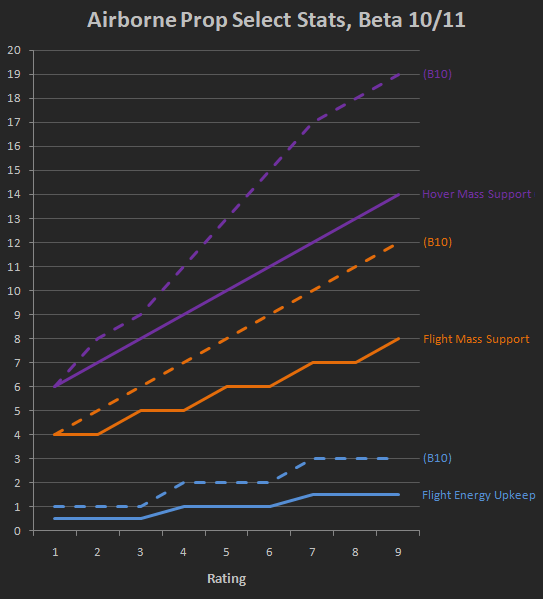
Base flight and hover stat progression, a comparison between Beta 10 and 11.
Values remain mostly unchanged in the early game, with the changes becoming more and more pronounced at higher ratings since the stats were adjusted via their rate of progression to prevent the best late-game airborne builds in particular from repeatedly becoming not only the fastest but also incredibly powerful by carrying heavy gear.
Speed alone gives a significant advantage in Cogmind, not to mention flight’s ability to hop over hostiles and escape or bypass almost any situation without fear of being boxed in, so it really shouldn’t also have access to some of the best direct combat setups.
Ideally, flight is hereby somewhat more restricted to a speedy stealth or hacker-type niche, and newly-nerfed hover can take over old-style combat flight builds, albeit at somewhat slower speeds and without the ability to hop. I say “somewhat” because even after the changes good players have proven it’s possible to put together some pretty powerful flight builds, just not quite as reliably or OP as before.
Of course with reduced mass support per unit there’s always the option to devote more slot evolutions to propulsion, thereby regaining some of what was lost, and although extra prop implies extra resource requirements to run them, it’s at least easier to do this due to flight’s lowered energy costs. Flight builds still won’t really get as heavy as they once were, or if they do the slot cost is much higher than before and such a build will be weaker in other areas overall.
Notice in the graph that I had to add decimals for this! This is actually one of the reasons why these sorts of adjustments to flight balance took so long to happen, because the relevant values were already too small to affect a different progression with whole numbers. I generally avoid using decimals on principle since they aren’t pretty or easy for players to calculate with, but finally had to bite the bullet here and reimplement a bunch of things to allow the game to accept these non-whole numbers… (almost all Cogmind code works with whole numbers). And all for a super simple set of 0.5, 1.0, and 1.5--no other weird numbers needed or used :P
The overall result is a more forgiving flight paradigm not quite as tightly balanced around having the best lightweight power generation available, so it’s a bit easier to get up and running so long as the goal isn’t to go for a heavy build (implying tons of prop slots). Thus although many players will view these changes as a big nerf, in the bigger picture they simply ensure that both hover and flight are further differentiated while better serving their intended niches.
Leg Upgrades
Speaking of niches, players have sometimes noted that legs don’t really have anything unique going for them.
This was intended, as legs are one of the most easily-acquired prop types with both decent integrity and middling speed (hence the recommendation that newer players use them), so I didn’t think they necessarily needed anything special, per se. But I eventually agreed that if we could find another effect suitable for them then it could be a worthwhile addition, especially since (as you’ll see further below) other changes in Beta 11 took away the only reason better players might opt to use them by choice (while overweight a triple-leg setup was still faster than treads).
Treads with their siege mode are already clearly the best direct combat option, so let’s further differentiate legs as the mobile combat option. They’re already somewhat faster than treads and therefore partway there, so what about another benefit while using that mobility during combat? Not in the same way as airborne prop, mind you, since raw leg speed isn’t nearly enough to benefit from that, but instead something more in terms of taking advantage of the potential for unpredictable movements while dodging attacks. So instead of basing it on speed, legs have modifiers based on current momentum. (Momentum in Cogmind is displayed on the HUD along with other movement info, increasing for each consecutive move in the same direction (up to 3), or -1 for moves in the same general direction, or resetting to 1 for moves in other directions.)
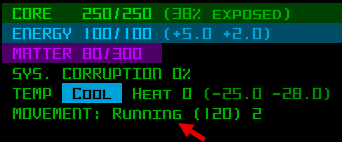
While moving (and therefore having momentum), the leg movement state in the HUD shows “Running” instead of the usual “Walking.” The current momentum there is 2.
For each level of leg momentum, shots against a robot* incur a -5% accuracy penalty, so the maximum penalty is 15% (*remember most mechanics, including these, affect all bots in the game, not just Cogmind!). Leg momentum also decreases accuracy of the moving bot by the same amount.
Some benefits of legs under this system:
- The most useful advantage is the ability to somewhat more safely reposition under fire when a combat situation changes, for example new enemies approaching from a different direction, or an important wall was destroyed, or a need to immediately grab certain parts nearby, or because of a crucial change to one’s build due to damage or other circumstances, or really any number of other reasons to move while fighting.
- Running into view of an enemy to initiate an attack (intentionally or not :P) at least has them open fire first while your evasion benefits are active, then you wait a moment to get your bearings and open fire with a much higher accuracy.
- Legged melee builds, which at least in my experience are fun and pretty decent, take less damage while charging a target or retreating to safety during a ranged confrontation.
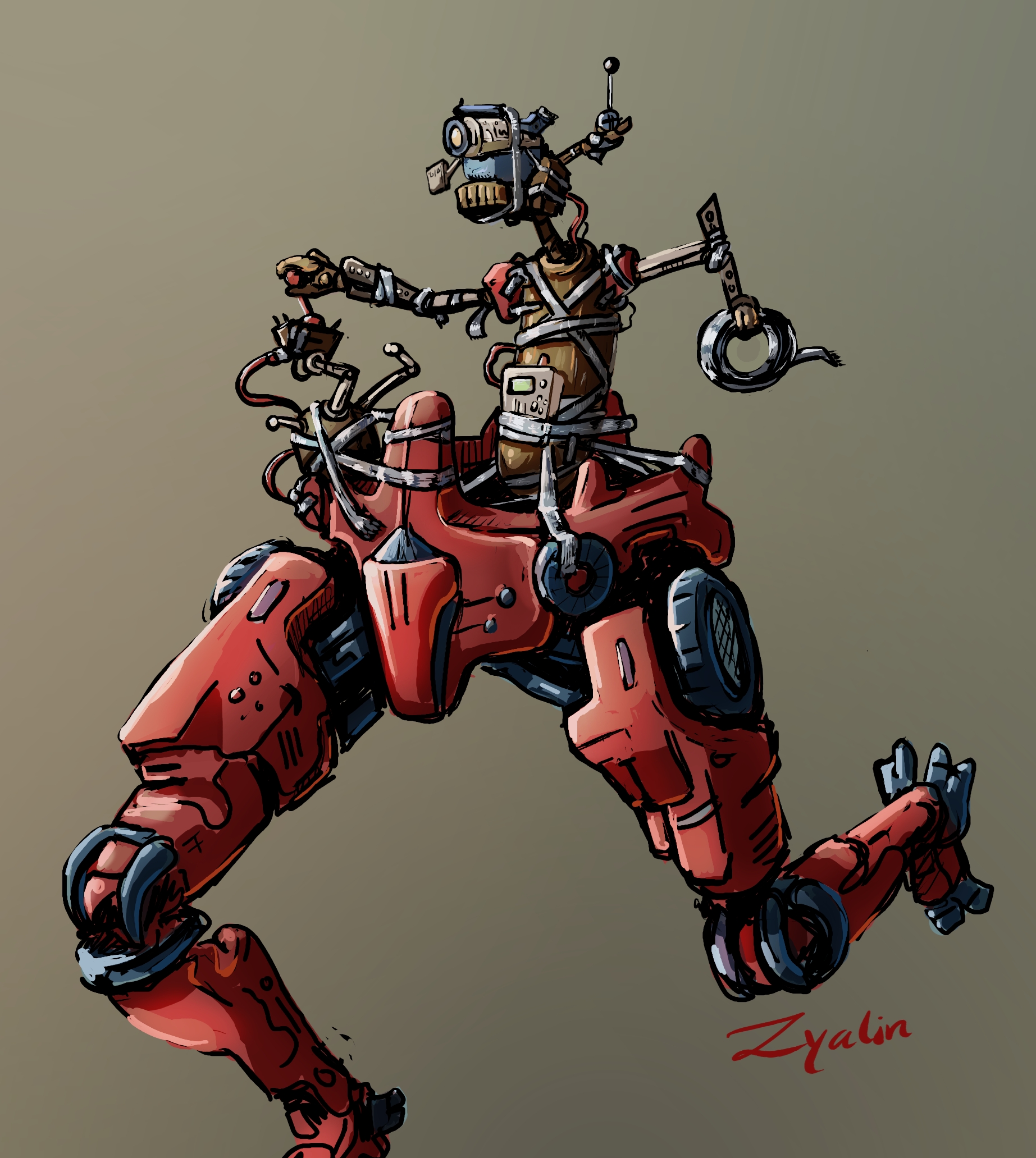
Even the derelicts know good legs when they see them (art by Zyalin).
As a bonus, players using legs to kick other bots out of the way also never take damage from the attempt. Earlier this required at least five legs for safety to be guaranteed, but that alone would never be reason enough for people to go with legs, and couldn’t even matter until relatively late in the game anyway.
Now we’ll definitely have some players opting to run non-overweight leg builds to complement their strategies. “Non-overweight” because the evasion bonus from running does not apply in that case ;). That said, I think we’ll see an even greater proportion of players trying to keep their builds underweight than before, anyway, due to other Beta 11 changes…
Overweight Penalties
Early in Beta 11 development there was an attempt to completely rethink Cogmind’s overweight mechanics, in particular the way exceeding a build’s mass support interacts with movement speed.
The basic idea was to switch from the original system of thresholds defined by how many multiples of a build’s mass support had been exceeded to instead find some kind of formula that would enable a more granular approach so that exceeding a threshold wouldn’t immediately have such a large impact on speed, and heavier builds on legs and treads would actually get progressively slower as they piled on more and more mass beyond their initial threshold.
Because on top of having five different prop types there are also so many potential combinations of slot counts and mass levels, even before building this new system I had to put together a ton of spreadsheets to test out reasonable values and formulas.

One of the early spreadsheets set up to easily see the effects of tweaking a set of core overweight values (open for full size).
Even with the spreadsheets it wasn’t easy to find an approach that would work without breaking everything, and at first I settled on a solution (depicted above, if you can decipher the chart…) that applies a single speed penalty on going overweight, as before, but after that includes a further speed reduction based on the amount of mass by which you exceed the threshold, rather than waiting to reach other thresholds.
The mass-speed relationship there was not linear, however, instead following an inverted exponential curve so that the effect is more pronounced earlier on and it gradually tapers off as a build’s mass grows. Although actually the opposite of what one might imagine should happen in reality, the point after all is to balance a game and in this case keep speeds within reason while still allowing for very heavy builds.
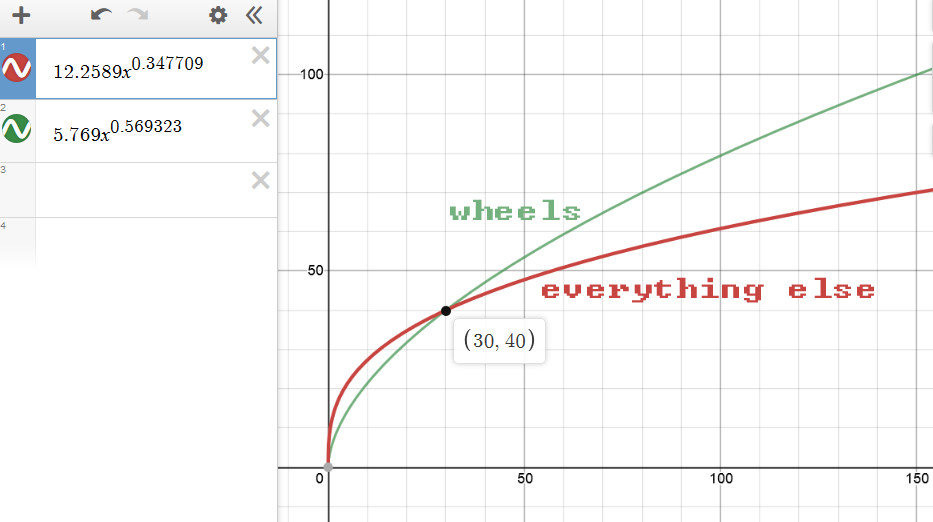
Sample overweight curves for speed mods over excess mass.
Multiple iterations were tested, including a single overweight formula, and a separate formula for wheels so they could retain their unique overweight interaction, and strong consideration was given to even having formulas specific to each class of propulsion.
Well none of it quite worked :P
There were too many oddities or ways to take advantage of the mechanics (or builds broken by the changes), not all that surprising considering the entire game was designed around the original system devised in 2012, which I’ve always actually liked a fair bit for its simplicity and consistency. Compared to using formulas, clear thresholds are easier for players to grasp and work with.
In the end it’s again kinda funny because this big system change was actually a sort of overreaction to what triggered attention to this mechanic in the first place: mass no longer mattering as a factor to treads and legs once they exceeded the first threshold. This experiment was mainly answering the call of numerous players inquiring about a potential granular overweight system, so I thought we’d try it out for a bit. Too bad it turns out “experimenting with it for a bit” actually took a huge amount of time, both because it was a complicated undertaking and because repeated attempts all failed xD
So the final overweight changes in Beta 11 actually end up being a lot more tame and targeted, more or less keeping the original system, but with significantly greater threshold penalties for overweight legs and treads :P
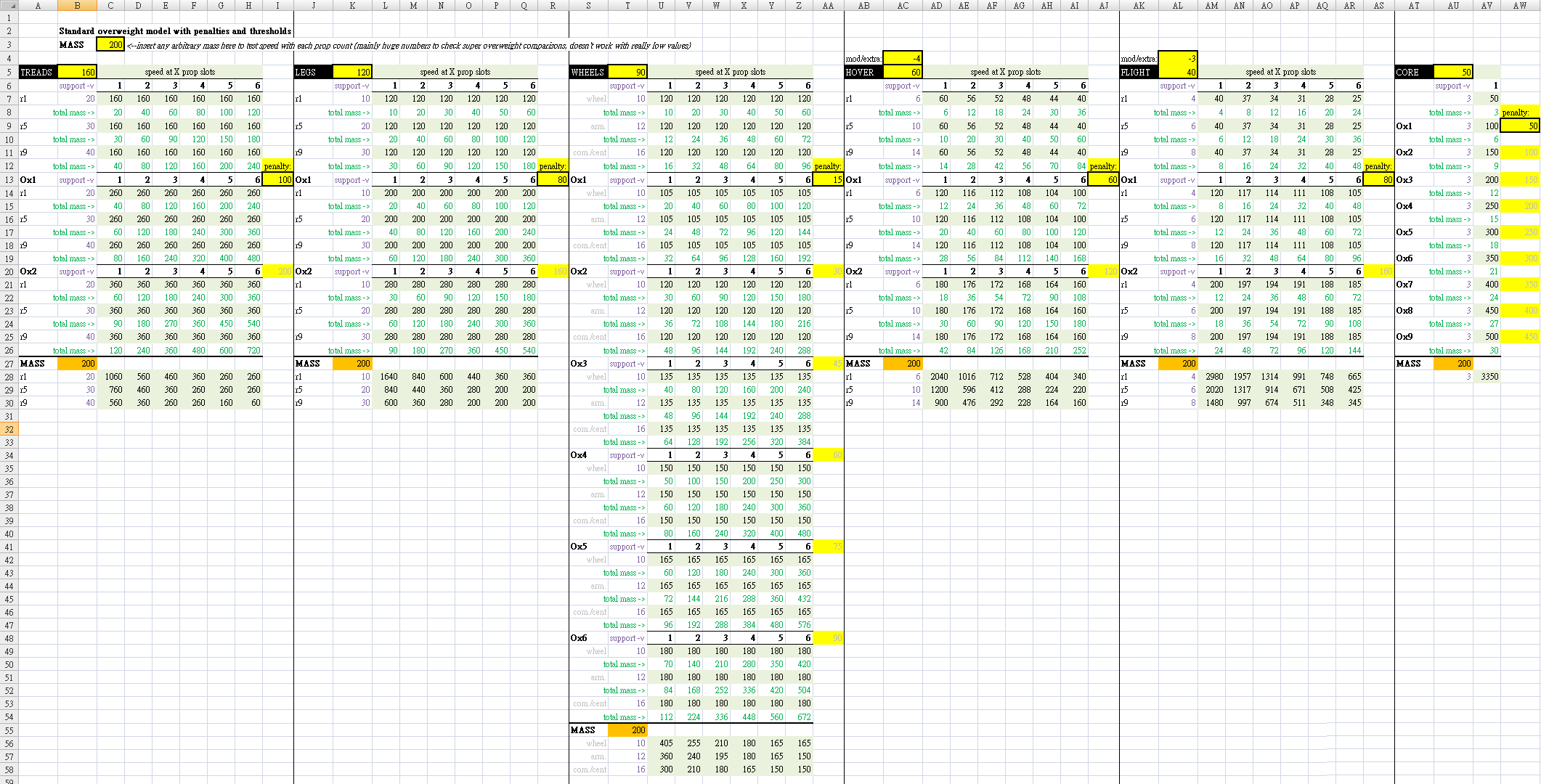
The final spreadsheet calculating speed modifiers based on Cogmind’s standard overweight threshold system (open for full size).
Overall due to the <no_stack> changes (and leg upgrades discussed earlier) I think more builds will start to lean towards being underweight anyway, either because they have more prop slots to play with (due to freeing up storage slots) or simply less mass support devoted to heavy Storage Units (since storage was usually the heaviest component of most builds).
Mass Support Utilities
A discussion of overweight propulsion and mass support isn’t quite complete without talking about the group of utilities that enable builds to increase their support threshold for a resource cost by allocating utility slots instead of just prop slots. Weight Redistribution Systems and their much more efficient high-rating kin are one of the main alternative ways especially faster builds could avoid going overweight (but without increasing speed which extra airborne prop would help with).
These have always been extremely problematic to balance against the normal propulsion mechanics--it’s pretty much impossible, in fact, given the nature of the systems involved, so despite multiple attempts to rework them throughout Cogmind’s history, it was finally about time to simply remove them…
However, players made some strong arguments for at least keeping them around in a no_stack capacity, which as discussed in the previous article is something I try to avoid whenever possible, but I do rather like the ability of mass support utilities to add a bit of flexibility to a build’s mass support via a utility slot (plus some of the other robot designs utilities these parts!), so we’ll go with that for now.
Sadly, gone are the days of powerful 2-slot flight builds.
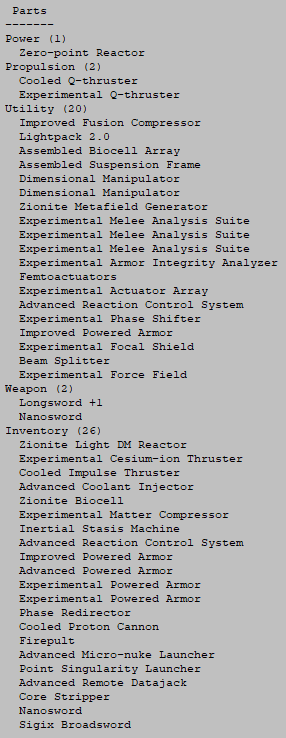
For posterity, here’s Valguris’ final 2-slot flight build from one of his Beta 8 double extended wins, as recorded in his scoresheet (see the full scoresheet here). It sports three mass support utilities among other crazy good parts. (Some item names might be minor spoilers.)
Part 3, now available, looks at further differentiating weapons with a wide variety of critical strikes, and other new related mechanics.

